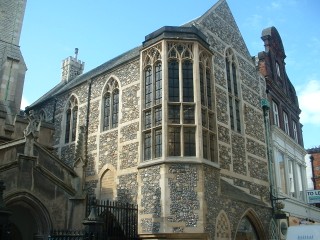
Listening to the introduction of the 2012 Henry Martyn Lectures, delivered by Dr Vinoth Ramachandra, spurred my curiosity with regard to:
- Who is Henry Martyn?
- What is his relationship to the subcontinent?
- How come there is an active centre and library at Cambridge, which now has a growing focus on the academic study of mission and world Christianity, named after him?
- Why celebrate the bicentenary of his death with events, seminars, services, an exhibition, and this capstone lecture series?
On the Henry Martyn Centre’s website I found a brief biography and a chronology of Henry Martyn’s (1781-1812) life. In addition, a quick on-line search resulted in a number of pieces declaring the passion Martyn had to “burn out for God.” I even came across Ravi Zacharias eloquently sharing and challenging his listeners with the story of this unbecoming Cambridge scholar/genius embracing the call to serve in India — choosing God over the interests of “his love.”
Henry Martyn’s missionary zeal to go where people have not heard the Gospel does not stand in opposition to A Mission to the University. In founding schools, preaching, and translating the New Testament into three languages (Arabic, Persian, and Hindoostani), Martyn did not scorn his scholarly gifts, but harnessed them their maximum as the first Anglican graduate missionary to India. As part of the mission, he engaged in dialogue wherever he traveled:
After an exhausting journey from the coast he reached Shiraz, and was soon plunged into discussion with the disputants of all classes, ‘Sufi, Mahommedan, Jew, and Jewish Mahommedan, even Armenian, all anxious to test their powers of argument with the first English priest who had visited them.'” — Henry Martyn. 1911 Encyclopedia Britannica. Web. <http://www.1911encyclopedia.org/Henry_Martyn>. Accessed 5/14/2013.
Furthermore, his encounters with the ugly nature of sin, war, and fallen humanity, inflamed his passion for incarnating/advancing the Gospel of peace in the midst of British colonialism (see Henry Martyn: Iraq- lessons in a time of war. Nick Megoran).
Did he not receive the training and the refinement of his skills in the University? Did not Henry Martyn come to Christ as a student at Cambridge? Did not his mentor Rev. Charles Simeon (1759-1836) have a passion for the discipleship of college students and the call of the Gospel to the ends of the earth, but continue to serve one campus through one church for 54 years (i.e., Holy Trinity Church, Cambridge, and Cambridge University)? Do we not find the world coming to us in and then being sent forth from the university — some even to other universities?
When I served at Carnegie Mellon University, the Graduate Christian Fellowship was founded largely by international students who were followers of Christ. Why did they desire such a fellowship? They yearned for a place to gather to encourage one-another as they wrestled with being salt, light, and leaven in all areas of life. They returned time after time to questions of Christ and culture, realizing that the campus (and global higher education in/across disciplines) itself is a unique, dynamic culture. Now they serve in various places, including universities, in a number of countries.
The Emerging Scholars Network has a passion not only for the Henry Martyns of the future to come to faith on campus, but also for each one of them to receive mentoring which engages the whole university context and by doing such enabling such men and women to extend the Kingdom of God wherever they are called to serve in this complex, interconnected era of missions . . . even some in the universities across the globe. Thank-you to Dr Vinoth Ramachandra for introducing me to this gift of resources and continuing dialogue on missions inspired by Henry Martyn and offered through the Henry Martyn Centre. To God be the glory!
To dig learn more about Henry Martyn, the Centre posted these articles of interest at the end of their brief biography.
“Foundations for Mission and the Study of World Christianity: The Legacy of Henry Martyn” Lecture given by Canon Graham Kings, HMC Director at the opening of the Henry Martyn Library at Westminster College, January 1996
“Martyn and Martyrs: Questions for Mission” Lecture given by the Rt Revd Dr Michael Nazir-Ali, Bishop of Rochester at the Centenary of the Henry Martyn Library, October 1998.
“Abdul Masih (1776-1827): An Icon of Indian Indigeneity.” Article by Canon Graham Kings, HMC Director, published in the International Bulletin of Missionary Research, 23/2 (April 1999).
Stay tuned for the developing series: A Mission to the University.
Tom enjoys daily conversations regarding living out the Biblical Story with his wife Theresa and their four girls, around the block, at Elizabethtown Brethren in Christ Church (where he teaches adult electives and co-leads a small group), among healthcare professionals as the Northeast Regional Director for the Christian Medical & Dental Associations (CMDA), and in higher ed as a volunteer with the Emerging Scholars Network (ESN). For a number of years, the Christian Medical Society / CMDA at Penn State College of Medicine was the hub of his ministry with CMDA. Note: Tom served with InterVarsity Christian Fellowship / USA for 20+ years, including 6+ years as the Associate Director of ESN. He has written for the ESN blog from its launch in August 2008. He has studied Biology (B.S.), Higher Education (M.A.), Spiritual Direction (Certificate), Spiritual Formation (M.A.R.), Ministry to Emerging Generations (D.Min.). To God be the glory!

Leave a Reply